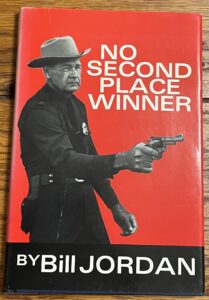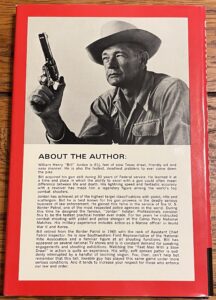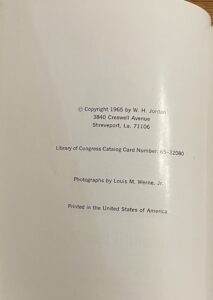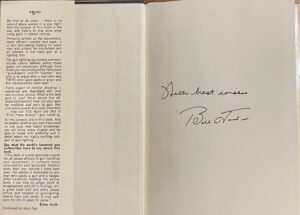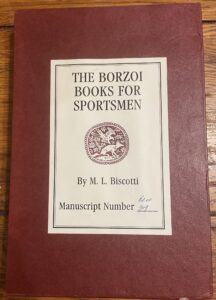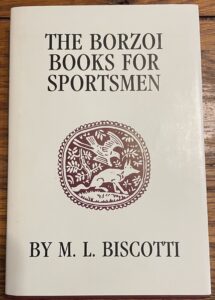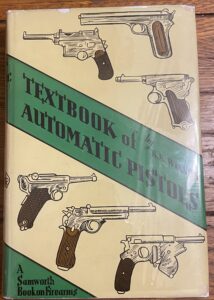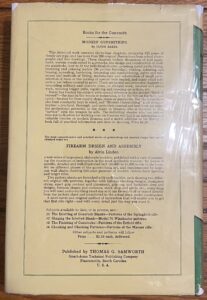…everywhere you go. At least, here on this blog.
Last Friday was my last day at work until January 8th. Some of this is me burning PTO before year-end, some of this is corporate holidays, and some of it is mandatory corporate shutdowns.
I’m planning to do more gun book posts and random gun crankery during my vacation, including a few things you’ve seen teasers for. So strap in, my people. It’s going to be a fun couple of weeks.
Why don’t we start out with a slice of history? After the jump…
No Second Place Winner, Bill Jordan.
Lawrence found this while book shopping in Dallas for $100 and asked me if I wanted it. I did. It was tagged (by Half-Price Books) and sold as a first edition. With no printers key, I can’t tell what printing it is. ABE Books is of no help, and Winner isn’t listed in any of my bibliographies, so I’m guessing first printing until shown that I’m wrong.
This is in really nice shape, mostly. Almost no edge wear, no dings or divots out of the jacket. The only issue is, the spine is badly faded.
I already have a copy of this, but I don’t think mine is a first. And this has one thing going for it that other copies don’t have.
It is signed by Bill Jordan. He passed away in 1997, so they ain’t making any more of these.
I’ve touched briefly on Mr. Jordan before. The video I posted of his gun handling is still up. Briefly, he was a working lawman with the Border Patrol and a war veteran. He’s often credited with several innovations: the “Border Patrol” or “Jordan” holster, the S&W Combat Magnum (later known as the Model 19), and was somewhat involved with the development of the .41 Magnum. (For more about Mr. Jordan, the Jordan holster, and the Combat Magnum, see these two posts at Holsterguys. There’s a nice tribute to him here as well. And, calling back to another of this blog’s obsessions, a very thinly disguised Bill Jordan is a character in Pale Horse Coming.)
Winner is an influential early guide for the lawman or other person who carries a gun in self-defense: how to chose your gun, your holster, your ammo, and how to use all of the above in combat.
The history of gun fighting fails to record a single fatality resulting from a quick noise.
Winner concentrates on shooting revolvers (as opposed to the automatic pistol), but many of the same general principles apply today. This is a nice piece of history that I’m happy to have.
The M1911 Complete Owner’s Guide, Walt Kuleck. This is a new book readily available from Amazon and the CMP Store.
I considered buying this when I got my CMP 1911. Then I got another 1911 pattern pistol. Then I got another 1911. Then I got some Amazon funny money from work. Then I put another 1911 on layaway. All of these are in addition to the 1911 pattern pistols I already owned.
My name’s Dwight, and I’m a 1911-holic. Like .22 handguns, I need another 1911 like I need another hole in my head.
(But I don’t have a 1911-pattern .22. I’m thinking what I really want now is a fairly early Colt .22 conversion kit for the Government Model. Something like this. For reasons. I also want to find some period correct 1911 .45 magazines, again for reasons. I hope to get up a post before I go back to work elaborating on those reasons.)
I’m only a little more than halfway through, but I feel comfortable recommending it. This book seems to cover everything about the 1911, from developmental history to a brief biography of Col. Jeff Cooper to detail stripping your 1911 (with notes on some of the 1911 variants and how the detail stripping process differs) to putting it all back together again (and some of the gotchas).
My one concern is that some of the information in the later chapters (on ammunition, magazines, and holsters) may be out of date. This book was originally published in 2010, but my copy is a fifth printing from March of 2023: it may have been updated, but I can’t say for sure. No matter what, I don’t think there’s a more comprehensive book on the mechanics of the 1911, so I strongly encourage any serious 1911 owner to add this to their reference library.
The Borzoi Books For Sportsmen, M.L. Biscotti. Sunrise Publishing Company, Madsion, Ohio, 1992.
I’ve written before about M.L. Biscotti and his bibliographies. My book buddy in the Association pointed me to this one on eBay and strongly recommended I buy it (and some other books as well).
I don’t know a lot about this subject yet, but as I understand it from the jacket copy: in 1926, Penn Publishing started publishing sporting books. Many of these books were well regarded. Penn was acquired by Alfred A. Knopf in 1943. Knopf continued publishing the Penn books under the Knopf-Borzoi imprint, and also brought out additional books for a total of 31 volumes. This is a comprehensive bibliography of these books, including printings after the first, photos of the books (with jackets when available), short biographies of the authors, and even a discussion of prices (circa 1992).
This is in nice shape. There are a few very small dings in the slipcase, but the book is perfect. It does have a bookplate from the original owner. M.L. Biscotti also signed this to the original owner, and laid in are two letters from Sunrise Publishing and from Mr. Biscotti to the owner.
Am I going to start collecting Borzoi books? That’s tempting. I’m still working on the Samworths, but I won’t rule out picking up some of the Borzoi hunting and shooting titles. Many of the Borzoi books seem to be about fishing, which I am slightly less interested in, so I might hold off on those until my Samworths are completed.
Still, you can’t have enough bibliographies. Or 1911 pattern pistols. Or .22 handguns.
Textbook of Automatic Pistols, R.K. Wilson. Small-Arms Technical Publishing Company, Plantersville, South Carolina, 1943. Riling 2457.
A history of the automatic pistol from 1884 to 1935. Not just military guns, but civilian pocket pistols (like the 1903 and 1908 Colts and the Savage pistols), with some coverage of submachine guns as well. Also, Lugers, Mausers, and the 1907 US Army trials (which led to the adoption of the 1911, and which are also covered somewhat in the Kuleck book). Smith says “There is no better book available on early autoloading arms.”
It seems like Robert Kenneth Wilson was an interesting guy. He was actually a practicing English gynaecologist and surgeon, and was part of the SOE during WWII. He also established himself as a firearms expert, and testified as an expert witness in court. He also “took” the famous photograph of the Loch Ness Monster, which has now been shown to be an elaborate fake.
This is a very nice copy. There’s a little bit of edge wear and some small divots at the top and bottom of the spine, and a crease across the back cover, but it is otherwise very clean. The ad page is dated December 1944, which would make it a second printing per Smith. Smith also describes this as “relatively scarce, as most owners tend to keep the work”.
The Wilson and Biscotti were bought, along with a third book I will not discuss at this time, as a package for $245 from an eBay seller. I think the Wilson and Biscotti are probably easily worth $100 if not more, so I feel like I got the third unnamed book for free. (No, it isn’t porn. I have a good reason for not disclosing it now.) As it turned out, the eBay seller was Crazy Lady Used Books and Emporium in Schertz, Texas. Schertz is just about an hour down the road from me, and the owners sent along a nice personal note inviting me to come visit. I’m hoping I can do that while I’m on vacation.
Next time: I have another interesting block of Samworths, plus nostalgia is (kind of) a moron. Also, I think: best mil.
Edited to add 1/3: the third book talked about above was a second copy of McBride’s A Rifleman Went to War. The reason I was being coy about it is that I bought that as a Christmas present for Lawrence, and didn’t want to spoil the surprise before Christmas. Now that the secret is out, I can update.
